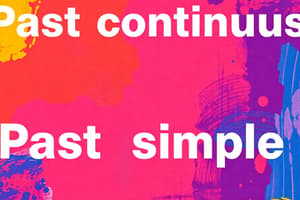Podcast
Questions and Answers
The past simple is typically used to describe ______ actions that happened at a specific time in the past.
The past simple is typically used to describe ______ actions that happened at a specific time in the past.
completed
The past continuous is used to describe actions that ______ in progress at a specific time in the past.
The past continuous is used to describe actions that ______ in progress at a specific time in the past.
were
To form the past continuous, you use was/were + the ______ participle of the verb.
To form the past continuous, you use was/were + the ______ participle of the verb.
present
We use the past continuous to describe the ______ of a scene in the past, often setting the stage for other actions.
We use the past continuous to describe the ______ of a scene in the past, often setting the stage for other actions.
In a narrative, the past continuous often describes an action that was in progress when another action ______ it, described in the past simple.
In a narrative, the past continuous often describes an action that was in progress when another action ______ it, described in the past simple.
The ______ tense is used to describe an action that was in progress at a specific point in the past, such as 'I was studying when you called'.
The ______ tense is used to describe an action that was in progress at a specific point in the past, such as 'I was studying when you called'.
If you want to describe a sequence of completed actions in a narrative, it is best to use the ______ tense.
If you want to describe a sequence of completed actions in a narrative, it is best to use the ______ tense.
When setting the scene in a story, the ______ can be used to describe concurrent activities, as in 'While she was cooking, he was cleaning'.
When setting the scene in a story, the ______ can be used to describe concurrent activities, as in 'While she was cooking, he was cleaning'.
The phrase 'last year' is a signal word indicating the use of the ______ tense, as it refers to a completed time frame.
The phrase 'last year' is a signal word indicating the use of the ______ tense, as it refers to a completed time frame.
To express that one action interrupted another in the past, structure your sentence to include the past continuous for the ongoing action and the ______ for the interrupting action, like 'I was walking when it started to rain'.
To express that one action interrupted another in the past, structure your sentence to include the past continuous for the ongoing action and the ______ for the interrupting action, like 'I was walking when it started to rain'.
Using the past continuous incorrectly to describe a completed action, such as saying 'I was going to the store yesterday,' can be corrected by using the ______ tense.
Using the past continuous incorrectly to describe a completed action, such as saying 'I was going to the store yesterday,' can be corrected by using the ______ tense.
When 'when' is used to introduce an action that interrupts another, the interrupting action should be in the ______, such as in the sentence, 'I was studying when he arrived'.
When 'when' is used to introduce an action that interrupts another, the interrupting action should be in the ______, such as in the sentence, 'I was studying when he arrived'.
The use of phrases like 'all day' or 'at 6 PM' typically indicates the use of ______ because they specify an action's duration or precise timing within the past.
The use of phrases like 'all day' or 'at 6 PM' typically indicates the use of ______ because they specify an action's duration or precise timing within the past.
Flashcards
Past Simple
Past Simple
Describes completed actions at a specific time in the past.
Past Continuous
Past Continuous
Describes actions in progress at a specific time in the past.
Past Simple Formation
Past Simple Formation
Base verb + '-ed' (regular verbs) or unique forms (irregular verbs).
Past Continuous Formation
Past Continuous Formation
Signup and view all the flashcards
Past Simple vs. Past Continuous
Past Simple vs. Past Continuous
Signup and view all the flashcards
Past Simple Duration
Past Simple Duration
Signup and view all the flashcards
Past Continuous Duration
Past Continuous Duration
Signup and view all the flashcards
Past Simple Use Cases
Past Simple Use Cases
Signup and view all the flashcards
Past Continuous Use Cases
Past Continuous Use Cases
Signup and view all the flashcards
Interrupted Actions
Interrupted Actions
Signup and view all the flashcards
Parallel Actions
Parallel Actions
Signup and view all the flashcards
Past Simple Signal Words
Past Simple Signal Words
Signup and view all the flashcards
Past Continuous Signal Words
Past Continuous Signal Words
Signup and view all the flashcards
Study Notes
- The past simple and past continuous tenses describe actions in the past, but they do so in different ways and are used for different purposes
- The past simple describes completed actions in the past, while the past continuous describes actions that were in progress at a specific time in the past
Past Simple
- Used to describe completed actions that happened at a specific time in the past
- Often used for:
- Single, completed actions
- A series of completed actions
- Actions that happened over a period of time that is now finished
- General truths or facts in the past
- Formation:
- Regular verbs: base verb + -ed (e.g., walked, played, watched)
- Irregular verbs: have unique forms (e.g., went, ate, saw)
- Examples:
- I visited Paris last summer
- She finished her work and went home
- They lived in that house for ten years
- The Earth was flat (according to some past beliefs)
- Time expressions commonly used include: yesterday, last week/month/year, ago, in 2005, and when
Past Continuous
- Used to describe actions that were in progress at a specific time in the past
- Often used for:
- Actions happening at a specific time
- Describing background scenes
- Interrupted actions
- Parallel actions
- Expressing annoyance or criticism about repeated actions
- Formation:
- Use "was/were" plus the present participle (base verb + -ing)
- Examples:
- I was watching TV at 8 PM last night
- The birds were singing, and the sun was shining
- She was walking down the street when she saw the accident
- While I was cooking, he was cleaning
- He was always complaining about something
- Time expressions commonly used include: while, as, at that time, when (to describe an interrupted action), and all day/night
Key Differences
- Completion vs. Duration:
- Past Simple: Emphasizes that an action was completed
- Past Continuous: Emphasizes that an action was in progress at a specific time
- Use Cases:
- Past Simple: Used for telling stories, describing a sequence of events, or stating facts about the past
- Past Continuous: Used for setting the scene, describing ongoing actions, or indicating that one action interrupted another
Common Uses Together
- Interrupted Actions:
- The past continuous describes the action in progress, while the past simple describes the interrupting action
- Example: I was eating dinner when the phone rang
- Parallel Actions:
- The past continuous can describe two or more actions happening at the same time
- Example: While she was studying, he was playing video games
Examples illustrating the difference
- "I watched a movie last night." (Past Simple - completed action)
- "I was watching a movie when you called." (Past Continuous - action in progress, interrupted by another action)
- "They played football yesterday." (Past Simple - completed action)
- "They were playing football when it started to rain." (Past Continuous - action in progress, interrupted by another action)
- "She lived in London for five years." (Past Simple - completed period of time)
- "She was living in London when she met her husband." (Past Continuous - action in progress at a specific time)
Signal Words
- Past Simple:
- yesterday
- last week/month/year
- [number] days/weeks/months/years ago
- in [year]
- when (as a conjunction to introduce a past simple clause)
- Past Continuous:
- while
- as
- when (as a conjunction to introduce a past continuous clause that is interrupted)
- all day/night/morning/afternoon
- at [time] yesterday/last night
Common Mistakes to Avoid
- Using Past Continuous for Completed Actions:
- Incorrect: "I was going to the store yesterday."
- Correct: "I went to the store yesterday."
- Using Past Simple for Describing Background Scenes:
- Incorrect: "The sun shined, and birds sang."
- Correct: "The sun was shining, and birds were singing."
- Misusing "When":
- Be clear whether "when" introduces an interrupting action (past simple) or gives context for an ongoing action (past continuous).
- "I was studying when he arrived." (Correct)
- "When I finished studying, I went to bed." (Correct)
Practice Tips
- Identify the Time Frame:
- Determine whether the action is completed or was in progress at a specific time
- Context Clues:
- Look for signal words that indicate either a completed action or an action in progress
- Think About the Emphasis:
- Decide whether emphasizing the completion or the duration of an action
Studying That Suits You
Use AI to generate personalized quizzes and flashcards to suit your learning preferences.




